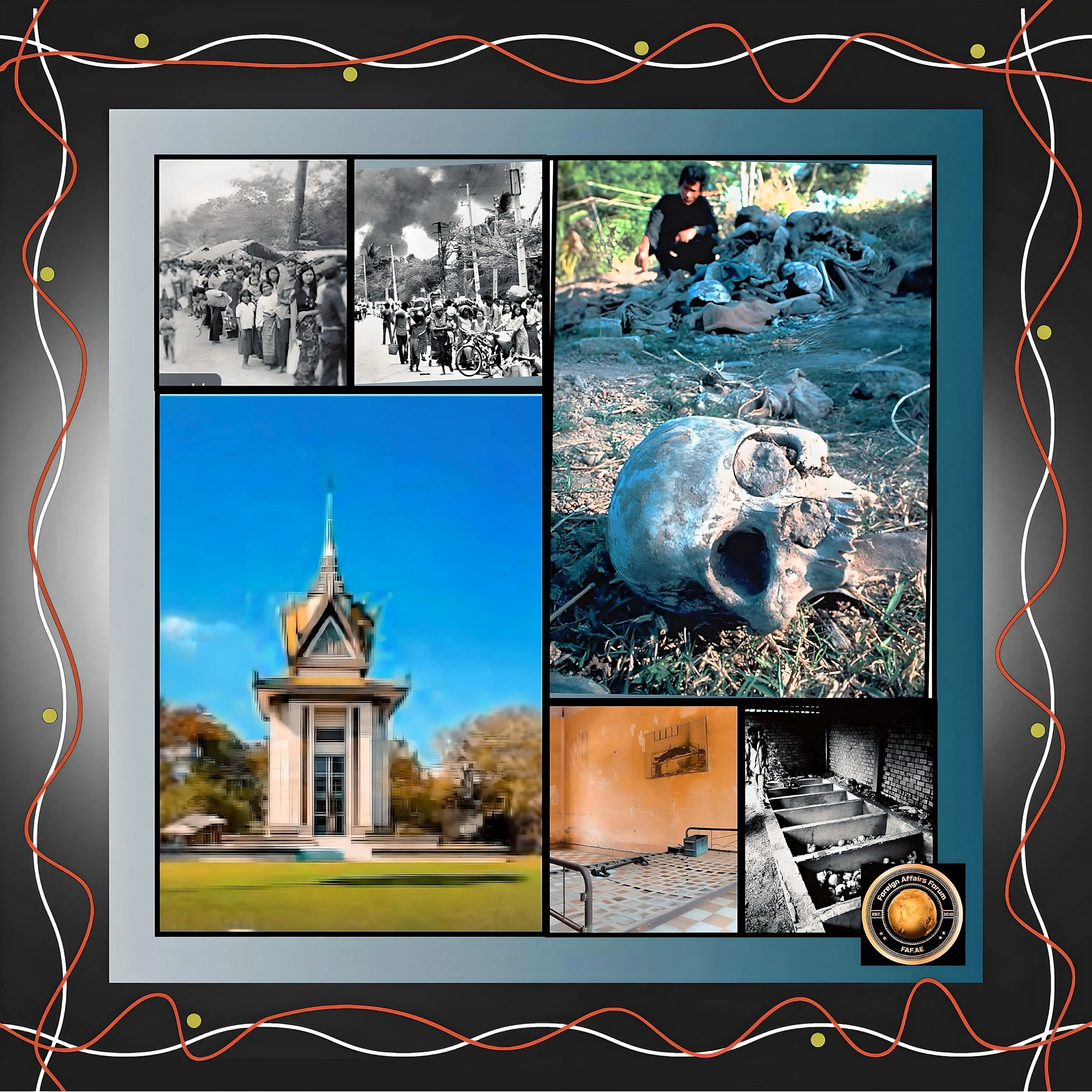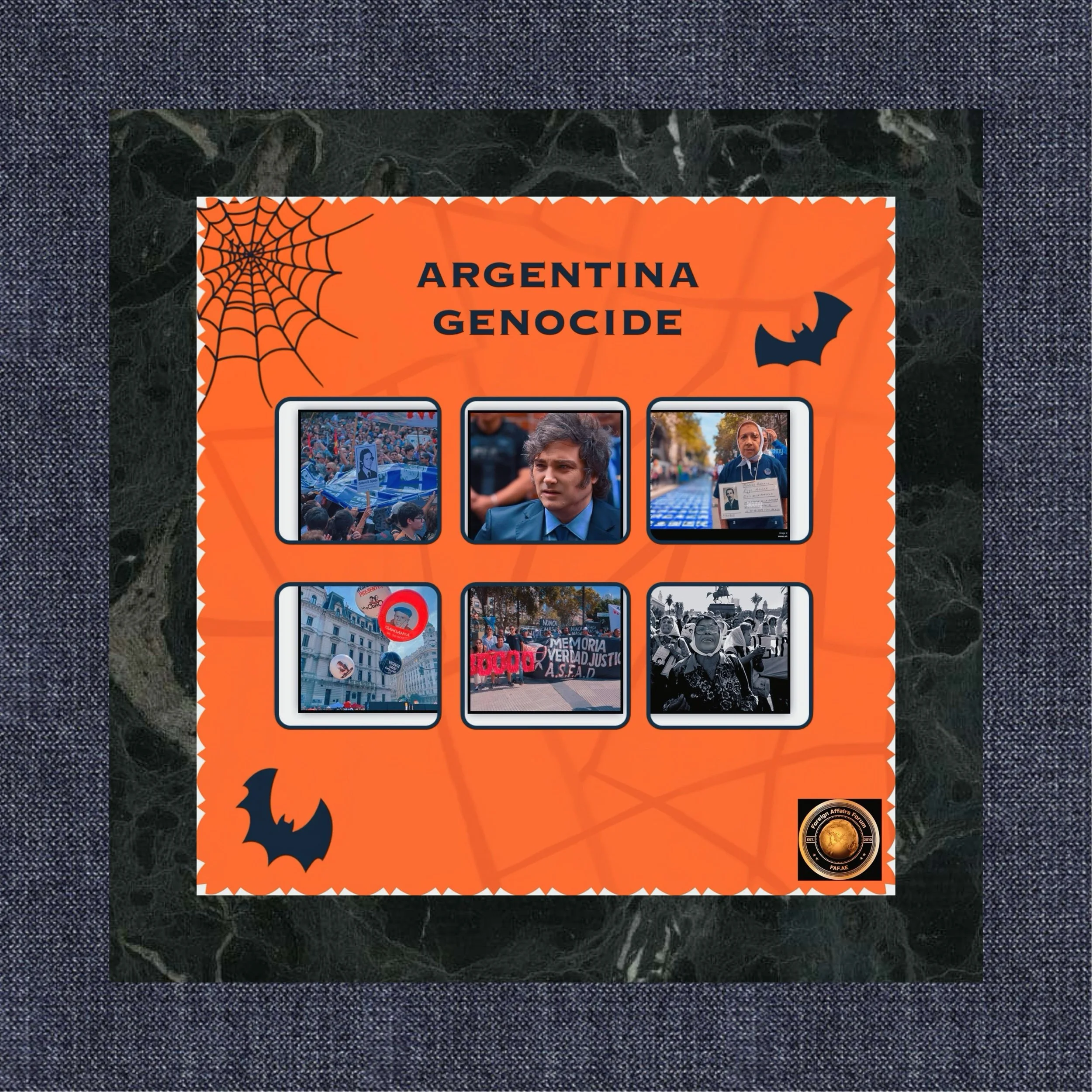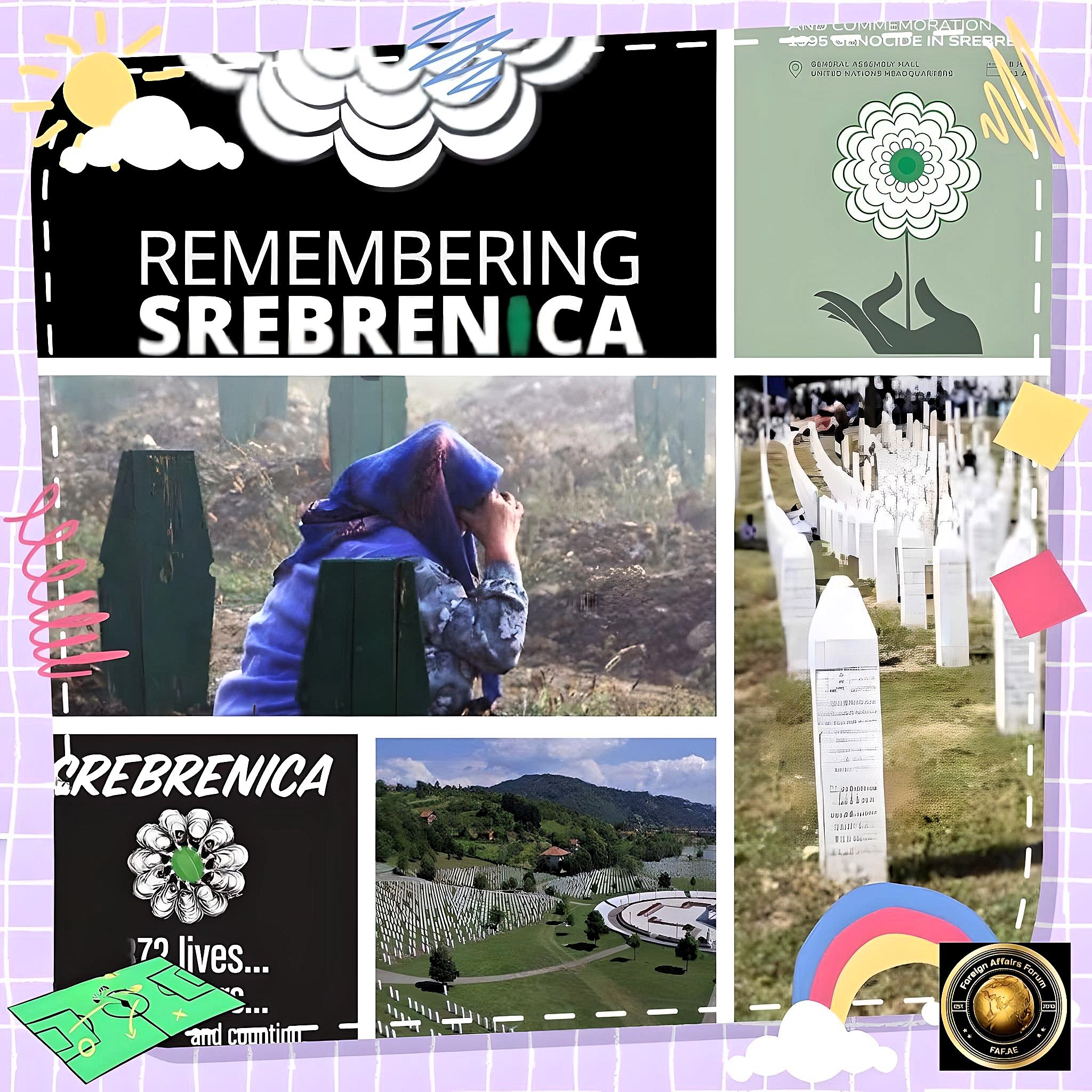The Cambodian Genocide: Remembrance, Impact, and Accountability
Introduction
The Cambodian genocide (1975-1979) under the Khmer Rouge regime resulted in the deaths of approximately 1.7-2 million people, representing nearly 25% of Cambodia’s population.
While often overshadowed by other 20th-century atrocities, this genocide has left profound and lasting impacts on Cambodia and its people.
Recent legislative efforts to criminalize genocide denial reflect ongoing attempts to preserve historical memory. At the same time, academic research continues to uncover the complex causes and long-term consequences of this dark period.
FAF examines whether the Cambodian genocide has been forgotten, its impact on Cambodian society, governmental responses, and the historical factors that led to this tragedy.
The Forgotten Genocide?
The Cambodian genocide has often been characterized as overlooked in international memory when compared to other atrocities.
It occupies a historical position “between the epic horror of the Holocaust and the more recent genocides in Rwanda and Bosnia that took place under the world’s gaze.” Several factors contributed to this relative historical neglect:
International Isolation and Limited Documentation
During the Khmer Rouge period, Cambodia was primarily isolated from the outside world. After the Vietnam War ended, significant powers and international media paid little attention to Indochina.
As a result, “reports by survivors came out in bits and pieces, almost all of them after the killing was over.” This isolation severely limited real-time documentation and international awareness.
Political Denial and Delayed Recognition
International recognition of the atrocities as genocide was delayed due to Cold War politics. Even after the Khmer Rouge’s fall, “the United Nations continued to recognize the deposed regime as the legitimate government of Cambodia.”
During the 1991 Paris Peace Agreements, “the major powers agreed to avoid using the word ‘genocide’ to describe their actions between 1975 and 1979,” mainly because nearly every prominent Cambodian leader in 1991 had at some point allied with the Khmer Rouge.
The United States notably “avoided describing Khmer Rouge atrocities as genocide until 1989, claiming it was ‘counterproductive to finding peace’”.
Overlooked Minorities Within the Genocide
Within the broader genocide, certain targeted groups received even less attention. The systematic persecution of Cham Muslims and other minorities constitutes what some have called “the forgotten genocide of the Muslim minority.”
The regime murdered an estimated “100,000 to 500,000 Cham Muslims and 20,000 Vietnamese”.
These targeted killings of ethnic and religious minorities represent a dimension of the genocide that has received insufficient scholarly and public attention.
Historical Context
What Led to the Genocide
The Cambodian genocide emerged from a complex interplay of ideological, political, and historical factors:
Radical Maoist Ideology
The Khmer Rouge, led by Pol Pot, implemented “an extremist program to reshape Cambodia based on the communist ideology of Mao’s China.”
They aimed to create an agrarian socialist republic by “eradicating social classes and Western influences from the country – creating a ‘Year Zero.’” China’s Cultural Revolution and ultra-Maoism directly influenced this ideology.
Chinese Support and Cold War Politics
The Khmer Rouge received substantial backing from China: “at least 90% of the foreign aid which the Khmer Rouge received came from China, including at least US$1 billion in interest-free economic and military aid in 1975 alone”.
In June 1975, “Pol Pot and other Khmer Rouge officials met with Mao in Beijing, receiving approval and advice.”
Meanwhile, Cold War dynamics led Western countries and Southeast Asian nations to continue supporting the Khmer Rouge for years, even after their atrocities became known.
Economic and Agricultural Ambitions
Contrary to some interpretations that the Khmer Rouge were simply anti-urban and anti-technology, research by geographers at Kent State University suggests they had specific economic goals.
They sought “to increase revenues to industrialize the country, which they accomplished by increasing rice production.” This required building extensive irrigation systems with forced labor, which became “one of the major contributing factors in the genocide.”
The Khmer Rouge selectively repopulated cities to ensure rice export distribution, indicating that their economic system was more complex than previously understood.
Scholarly Debates on Causation
Academic interpretations of the genocide’s causes vary significantly. Some scholars like Michael Vickery viewed it “principally as the result of a peasant revolution aimed at overthrowing the educated elite, and not the result of communist ideology.”
Others, including Ben Kiernan, argue that “Khmer Rouge leaders with the maximum power and responsibility for the genocide were centered around Pol Pot at the Party Centre in Phnom Penh.” This indicates a centrally planned effort rather than spontaneous peasant violence.
Pre-existing cultural factors also played a role, as “the pre-existing cultural and psychological characteristics of Cambodia not only emphasized obedience but led the society to accept the use of violence as a political tool.”
The Human Impact
Suffering and Consequences
The genocide’s impact on the Cambodian people was devastating and continues to reverberate today:
Systematic Killing and Forced Labor
The Khmer Rouge emptied cities and forced Cambodians into rural labor camps where “mass executions, forced labor, physical abuse, torture, malnutrition, and disease were rampant.”
Execution methods were often brutal and primitive: victims “were taken to the Killing Fields, where they were executed (often with pickaxes, to save bullets) and buried in mass graves.”
The Documentation Center of Cambodia has mapped “23,745 mass graves containing approximately 1.3 million suspected victims of execution”.
Prison System and Torture
The regime operated at least 196 prisons, with Security Prison 21 (S-21) being the most notorious. At S-21, located in Phnom Penh, “accused ‘traitors’ and their families were brought, photographed, tortured, and killed.”
Only about a dozen survived of the approximately 17,000 people detained at S-21.
Targeted Persecution of Minorities
The Khmer Rouge’s violence specifically targeted ethnic and religious minorities. “By decree, the Khmer Rouge banned the existence of more than 20 minority groups, which constituted 15% of Cambodia’s population”.
Cham Muslims were particularly persecuted: “If they (Khmer Rouge soldiers) happened to hear us speaking Cham language, we would be taken away and killed.”
Religious practice was forbidden, and “Qurans were ‘collected from houses and burned’ by Khmer Rouge cadres.”
Ongoing Trauma and Multigenerational Impact
Survivors continue to bear physical and psychological scars decades later. Sophari Ashley, who survived the genocide, testified: “I suffer poor physical health as a result of the malnutrition, the over-work and beatings which I faced under the Khmer Rouge.
And emotionally, too, I still bear the scars. I suffer from anxiety and nightmares when reminded of what I went through”.
Economic Consequences
The genocide’s economic impact persists into the present: “More than 40 years on, the households and villages most ravaged by Khmer Rouge atrocities are among the poorest”.
While Cambodia has shown impressive economic growth in recent decades, “averaging 5.5% annually,” the effects of genocide continue to hamper development.
Remembrance and Justice: Addressing the Past
Efforts to commemorate the genocide and hold perpetrators accountable have evolved over decades:
The Path to Justice
The process of seeking justice for Khmer Rouge crimes has been protracted and complex. After the Vietnamese overthrew the Khmer Rouge in January 1979, Pol Pot and Ieng Sary were tried in absentia and convicted of genocide. However, comprehensive justice was delayed for decades.
In 2001, the Cambodian National Assembly established “the Extraordinary Chambers in the Courts of Cambodia (ECCC), commonly known as the Khmer Rouge Tribunal.”
This tribunal received international support through the United Nations Assistance to the Khmer Rouge Trials (UNAKRT).
Between 2006 and 2022, five top Khmer Rouge leaders were prosecuted, with three eventually convicted.
Documentation Efforts
Since 1981, organizations including “the Cambodian Genocide Project, Yale University’s Cambodian Genocide Program, and the Documentation Center of Cambodia have gathered evidence from eyewitnesses, collected hundreds of thousands of pages of documents, and mapped thousands of mass graves.”
These efforts have been crucial in preserving historical records and supporting legal proceedings.
Commemoration
Cambodia observes May 20 as the “National Day of Remembrance” to commemorate genocide victims.
The date was formally designated in 1984 and marks when “the Khmer Rouge campaign against private citizens began.” Initially observed as a “Day of Hate” or “Day of Rage,” the commemoration has evolved to focus more on “education and remembrance.”
Current Efforts: Recent Legislative and Commemorative Actions
Recent years have seen renewed efforts to address the genocide’s legacy
Anti-Denial Legislation
In 2013, Cambodia passed a law against the denial of Khmer Rouge crimes, prescribing imprisonment of “six months to two years and fines between one million and four million Riel ($250 to $1,000)”. In January 2025, the Cambodian government approved a draft bill to strengthen these penalties.
The revised law passed in February 2025, imposes harsher penalties of “one to five years imprisonment and 10 million to 50 million riels ($2480 to $12,400)”.
The legislation aims to “prevent a repeat of the Khmer Rouge’s crimes and provide justice for victims.” However, critics argue that these laws could potentially “stifle historical debate” and may be used to “suppress political dissent.”
International Recognition
Efforts to secure international recognition continue. In April 2024, US Representatives Lori Trahan and Robert Garcia introduced legislation to designate April 17, 2025, as Cambodian Genocide Remembrance Day in the United States.
This follows similar resolutions passed in 2019 by Lowell, Long Beach, and Los Angeles, cities with significant Cambodian-American populations.
Approaching the 50th Anniversary
With April 2025 marking the 50th anniversary of the Khmer Rouge takeover, there is renewed focus on remembrance. The passage of the revised anti-denial law comes “just two months before the 50th anniversary of the Khmer Rouge’s rise to power on April 15, 1975”.
This anniversary represents an essential milestone for commemoration and historical reflection.
Conclusion
Memory, Justice, and Moving Forward
The Cambodian genocide, while sometimes overlooked in global consciousness, continues to shape Cambodia’s national identity and political landscape. After decades of delayed recognition and justice, significant efforts are now to preserve historical memory and hold perpetrators accountable.
Establishing the ECCC, annual commemorations, and anti-denial legislation, all represent attempts to acknowledge this dark period of history.
However, challenges remain. Political sensitivities continue complicating historical discussions, and some critics worry that anti-denial laws could be weaponized for political purposes.
The deep trauma experienced by survivors and their descendants requires ongoing attention to mental health and social recovery.
As Cambodia approaches the 50th anniversary of the genocide, the tension between remembering the past and building the future remains central to national discourse.
Ultimately, the Cambodian genocide stands as a stark reminder of humanity’s capacity for cruelty and the importance of international vigilance against atrocities.
By acknowledging this history and understanding its causes, perhaps the international community can better fulfill its promise of “never again.”






